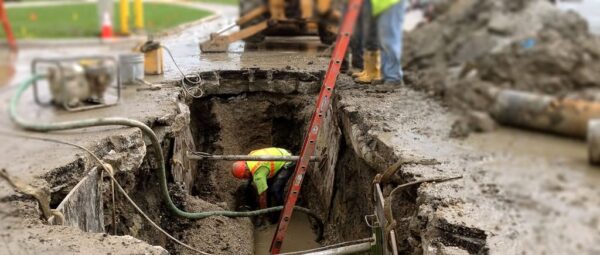Much has been said about the immediate benefits of 2nd Generation ATP monitoring to reveal regrowth hotspots in water distribution system. Having this data available in the field enables water technicians to instantly flag water samples that contain elevated microbiological content, trace the problem to its source, and then guide maintenance activates (e.g. flushing) in real-time to adequately solve the problem without being wasteful of time or water in the process. However, the long-term benefits of an optimized water quality monitoring program guided by ATP monitoring can yield even greater economic benefits.
Perhaps the most costly of all issues that drinking water utilities deal with is repairing line breaks. In the USA, drinking water utilities typically experience 23-27 line breaks per 100 miles of pipe per year, each of which carrying a direct cost of approximately $3000 for each event (Kirmeyer, Richards, and Smith, 1884). Based on these figures, the following examples put this cost in perspective:
Table 1: Sample of Cities of Various Sizes and Anticipated Line Break Frequency
| Location | Mile of Pipe | Projected # of Line Breaks | Anticipated Repair Costs* (USD) |
| Phoenix | 5,400 | 1350 | $4,050,000 |
| Dallas | 4,600 | 1150 | $3,450,000 |
| Kansas City | 1,912 | 478 | $1,434,000 |
| Macon | 1,400 | 350 | $1,050,000 |
*Assuming 25 line breaks/100 miles of pipe/year
Based on the results shown in Table 1, the costs associated with line break repairs can put a tremendous burden on water utilities so it is certainly in the best interest of the city to minimize these costs. Investigating the issue further, it has been reported that of the total number of line breaks, typically 50% are due to construction accidents that accidentally penetrate water lines. That leaves the other 50% being due to degradation of the pipes itself which is very strongly influenced by the effectiveness of the microbiological control that the utility maintains. The control of the following corrosion-causing issues can be directly addressed through an enhanced water quality control program using ATP monitoring:
- Microbially-Influenced Corrosion (MIC) – Elevated microbiological growth within water distribution lines inevitably result in biofilm formation. The adverse effects of biofilm are many (e.g. corrosion, premature loss of disinfectant residual, protection of biomass from disinfectant, etc.) and it is also very time-consuming to remove it through flushing. Repeated formation of tubercles and their subsequent removal through aggressive flushing also take their toll on the integrity of pipes.
- Chlorine/Disinfectant Dosage – As mentioned in the previous point, the tendency of biofilm to prematurely consume disinfectant residual usually results in treatment facilities boosting the dosage to ensure that a sufficiently high residual is maintained throughout the system. The corrosiveness of chlorine then becomes an even bigger issue with more of it needing to be added. Maintaining water quality through ATP monitoring can result in reduced biofilm presence which would otherwise consume disinfectant and further promote corrosion.
Needless to say, bolstering your microbiological control program using 2nd generation ATP monitoring enables water managers to get out in front of this problem by properly handling distribution system regrowth in a pro-active way rather than reactively. Assuming that corrosion can be reduced by as little as 10% through enhanced water quality control (a conservative estimate) would still translate to enormous savings that would eclipse the investment involved in adopting 2nd generation ATP monitoring and produce tremendous economic returns. This also says nothing of the much more immediate ROI that would be seen through flushing and field service optimization by saving tremendous amounts of water as well as time.
Reference:
Kirmeyer, G.J., W. Richards, and C.D. Smith. 1994. An Assessment of Water Distribution Systems and Associated Research Needs. Denver, Colo.: Awwa Research Foundation and American Water Works Association









